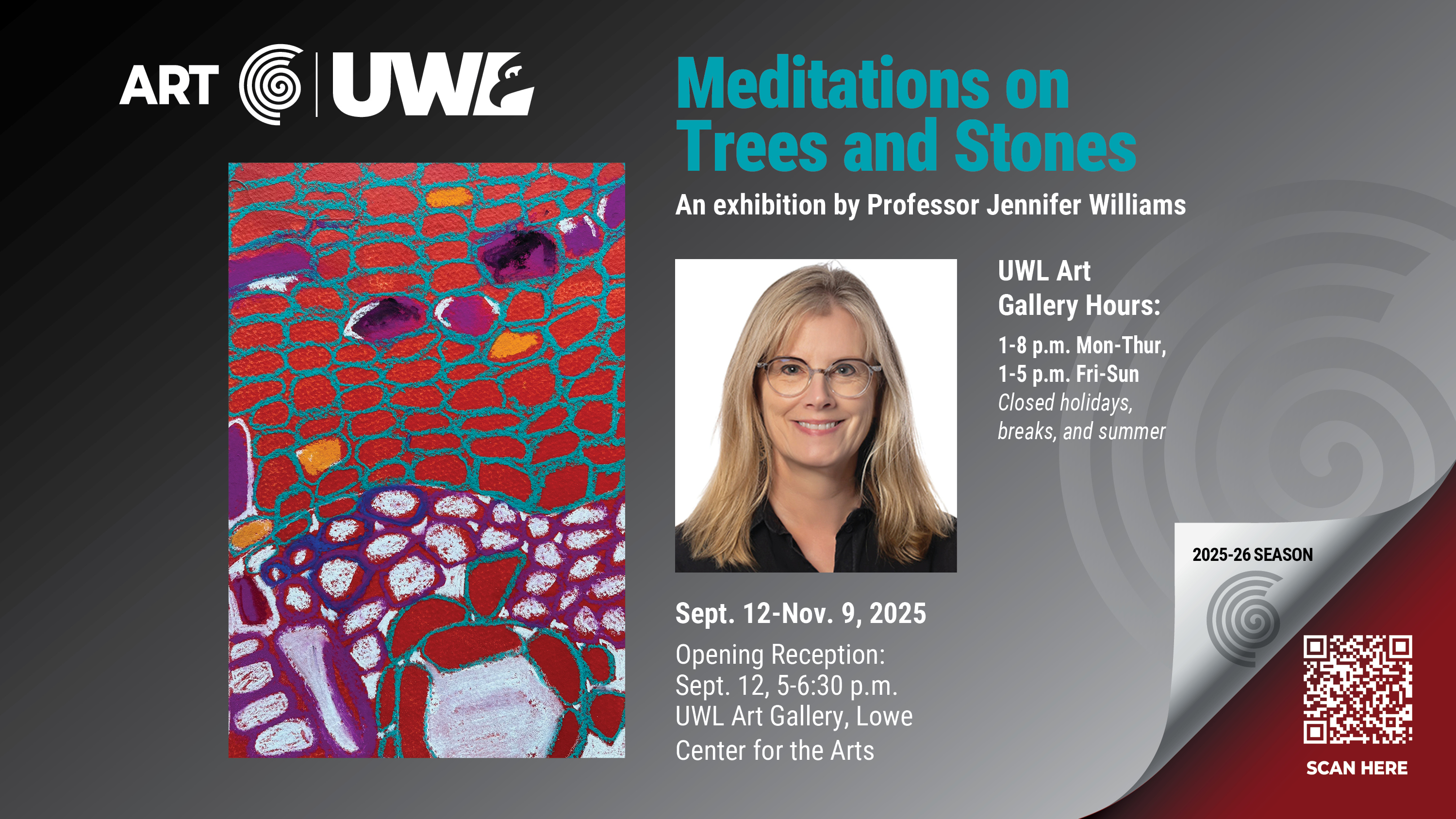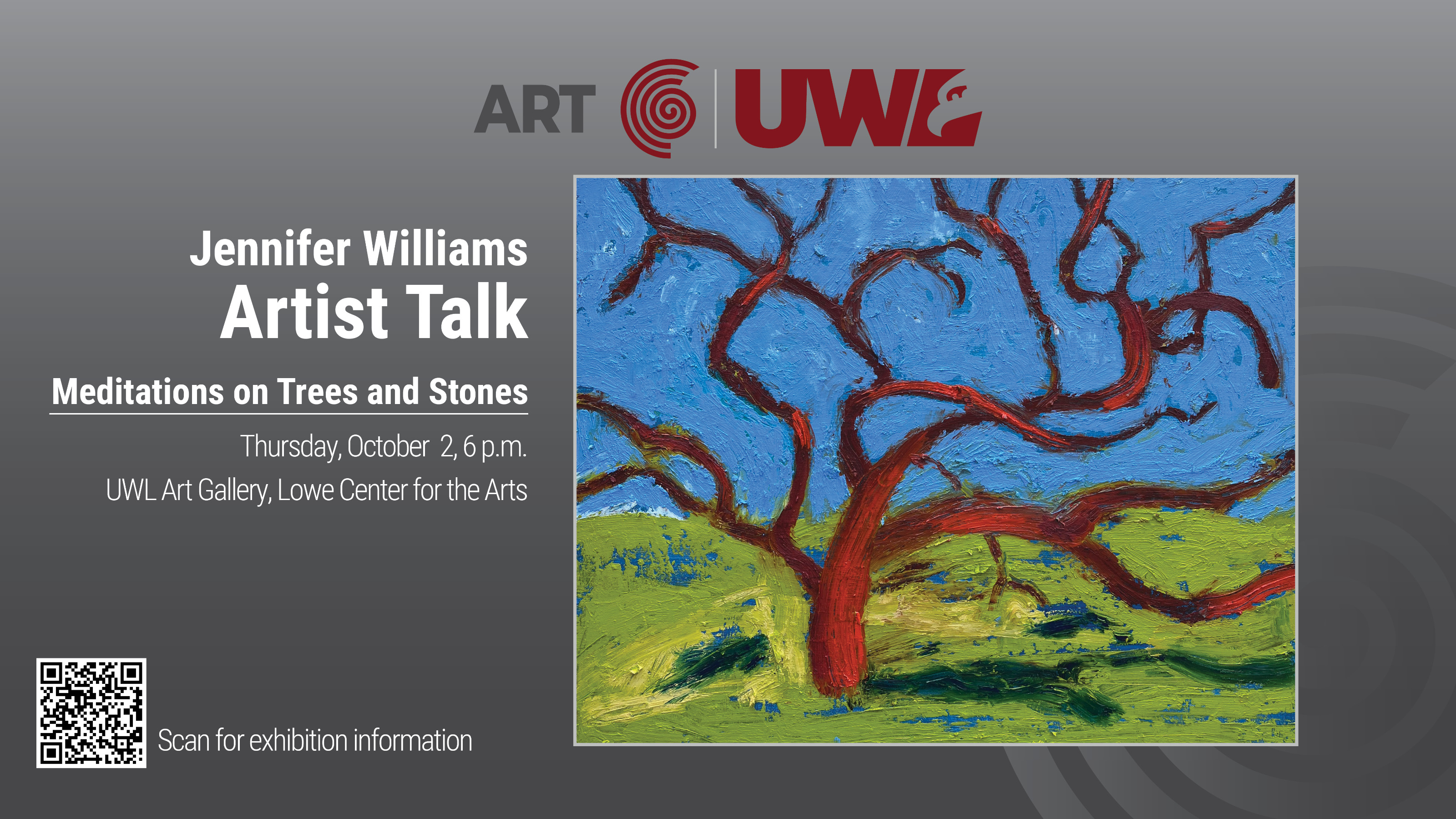Visual & Performing Arts
“Meditations on Trees and Stones…”: Jennifer Williams' Journey Through Landscape, Memory, and Renewal
This fall, the University Art Gallery at UW–La Crosse will host a deeply personal and visually expansive exhibition by Professor Jennifer Williams. Titled “Meditations on Trees and Stones…”, the exhibition is both a reflection on her recent sabbatical and a celebration of the cyclical nature of art, life, and learning.
At first glance, the show’s title feels like an ellipsis trailing off mid-thought—a pause pregnant with possibility. For Williams, that’s precisely the point. “I like that the title offers a sense of mindfulness like one discovers through the practice of meditation,” she says. “The state of creative flow is closely related to meditation, when being fully present in the process of artmaking suspends time and ideally, distracted thought. Being with a drawing or painting, collected stones or favorite trees can invite an attentive presence.”
A Sabbatical on the Road
Williams spent her Spring 2024 sabbatical in motion. She began with a two-week immersion in Mexico City and Oaxaca, soaking in the rich cultural heritage and vivid color palettes far removed from her own. “There’s such a strong history of painting in Mexico,” she notes, “a blend of European and deeply rooted indigenous traditions. The textures, the colors—they’re alive in a way that surprised me.”
That journey was followed by a 5,800-mile road trip through the American Southwest in April. It was a landscape Williams had long admired but never truly experienced. “I’ve always been inspired by the mythology of the open road,” she explains. “It’s been a recurring theme in my work since grad school. But being in the desert in full bloom after a wet winter—that was something magical.”
She documented her travels with sketches, photographs, and journal entries. Some paintings were begun on site; others emerged later in the studio, shaped by time, memory, and introspection. “You don’t know how travel will influence your studio practice until you fully engage in it,” she says.
Walls, Roads, and Reverie
The works in “Meditations on Trees and Stones…” span a variety of media—oil, watercolor, acrylic, and encaustic—a process involving pigmented beeswax that Williams calls “sculptural, sensory, and endlessly reworkable.” Many paintings draw from the visual language of roads and borders. Others are inspired by walls in Mexico, layered with generations of repairs. “I’ve been riffing on these surfaces—where the repairs are made with different colors of mortar or stone. They’re like abstract maps of time. Trees and stones both embody measurements of time, from growth rings to geologic time scale,” she says.
These pieces are both literal and metaphorical, encouraging viewers to reflect on their own paths, detours, and returns. “Some of the paintings feel like a road—taking you somewhere,” Williams says. “Others invite you to linger and wonder.”
Her work, while not overtly political, carries subtle reflections on access, privilege, and displacement—particularly in her experiences near the U.S.–Mexico border. “You can’t travel responsibly without considering your freedom to move—and someone else’s lack of freedom to do the same. I also feel a part of a movement in contemporary art called “para-pastoral,” which involves a reframing of the landscape away from purely idyllic views toward considerations of climate change, ecological, social and economic imperatives.
From Studio to Gallery: A Teaching Space
True to her identity as both artist and educator, Williams is extending the reach of “Meditations on Trees and Stones…” into the adjacent Study Gallery. This companion show will feature plein-air paintings created not just by her, but by her students as well. “There’s something honest about work that’s made on site, in real time,” she says. “It’s vulnerable and immediate—especially when you're painting outside, dealing with curious strangers as well as shifting light.”
Students who are participating in the 12th Annual Between the Bluffs Plein-Air Festival this fall will have the chance to exhibit their work alongside Williams’, inviting a dynamic conversation between faculty and student, teacher and learner.
“There’s an indelible curiosity that comes from being in the landscape,” she reflects. “It’s a way of recording sensory information in a limited window of time, without being beholden to a photo. It’s part performance, part memory, all intuition.”
An Invitation to Wonder
Whether it's a large-scale encaustic triptych or a modest plein-air sketch, each piece in “Meditations on Trees and Stones…” invites viewers to explore—to meander through color, line, and form, to let memory and imagination play. “I hope that people travel a bit into the work,” Williams says. “That there’s a sense of curiosity that keeps them in that space just a little longer.”
The exhibition spans small and large works, organized so that “paintings talk to each other.” As viewers move between pieces, they are asked not just to observe, but to participate—to begin, again, with each encounter.




